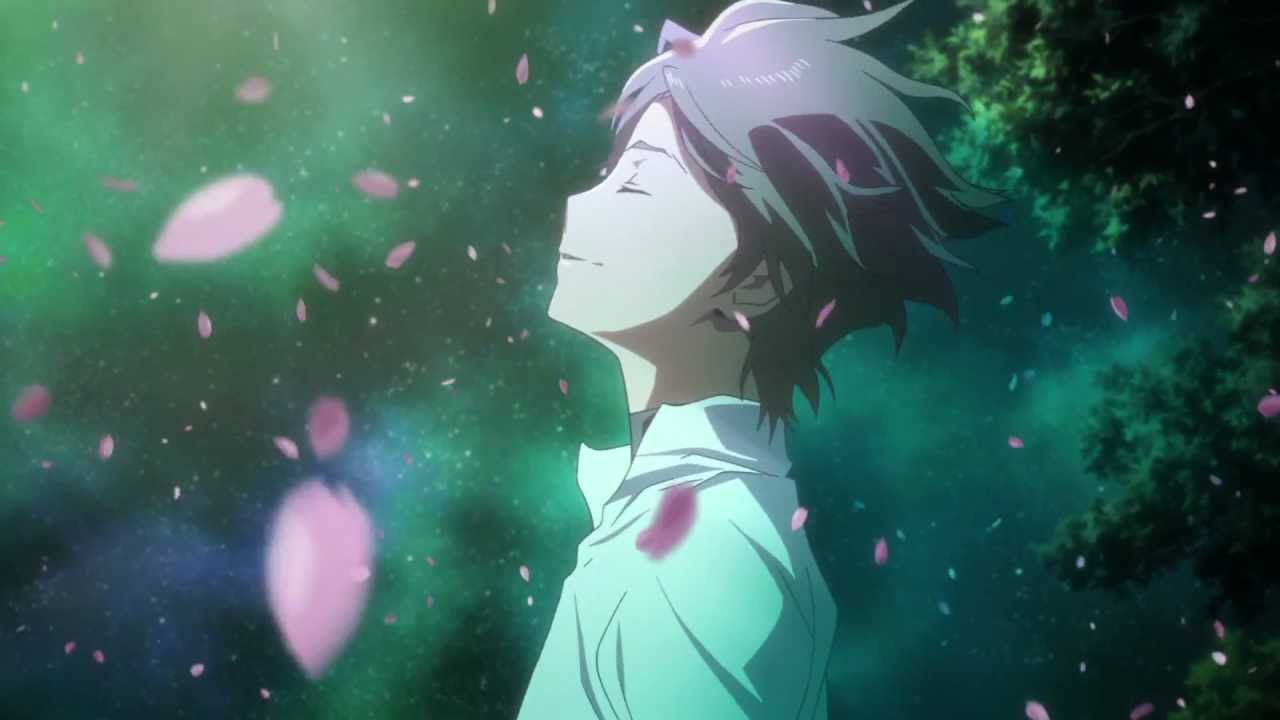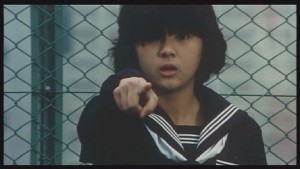Psychic School Wars
May 18, 2016 · 0 comments
By Andrew Osmond.
 “The wind is sweet… So this is Earth?”
“The wind is sweet… So this is Earth?”
Nerawareta Gakuen, like many other anime, begins with a transfer student arriving at a Japanese high school. In this case, we’re immediately tipped off that he’s not from Earth, nor from this time; he possesses a large glass jewel resembling an hourglass, which can turn into a dog-like animal that talks to him. But the transfer student is far more interested in the world he’s arrived in, which is ostensibly our own, but transfigured by the film into a lambent kaleidoscope of gorgeous colours flaring off virtual lenses. The look has been compared to Makoto Shinkai’s anime, but if so, it’s to his more far-out visions, like the cosmic sunset midway through 5 Centimetres per Second. However, Gakuen’s character animation is far more expressive than Shinkai’s, its youngsters bouncing with energy.
Despite the science-fiction set-up, and despite having a science-fiction plot of sorts, Nerawareta Gakuen is most successful as a wistful romantic teen drama. It’s the kind where everyone is unrequitedly in love with someone else, trapped by feelings they long to have returned. During the film, the high-schoolers rehearse A Midsummer Night’s Dream, with the alien boy identifying himself with Puck; but Dream, remember, is a comedy about characters falling for the wrong people. One anime that Gakuen recalls is the 2012 series Waiting in the Summer, another story of an alien joining an unknowing group of teenagers and wondering at the dreams of adolescence: sun and sea, friendship and love. The setting is the coastal region around the Japanese isle of Enoshima – exactly the same location as another new Anime Limited release, Ping Pong, but drawn very differently here.
 Officially, Nerawareta Gakuen is adapted from an oft-told science-fiction tale, dating back to the 1970s. The original novel by Taku Mayumura, the name of which literally means “School in Peril,” was published in 1976. The story is about a menacing group of students who dominate an ordinary high school, and turn out to have paranormal powers; meanwhile, other students fight back. The Dorama Encyclopedia links this to the rise of truculent, protest-minded students in the 1960s and 1970s, in Japan and around the world. However, it’s a perennially popular subject, in the likes of the horror film The Faculty and the British kid’s favourite The Demon Headmaster (where the titular villain is a super-hypnotist).
Officially, Nerawareta Gakuen is adapted from an oft-told science-fiction tale, dating back to the 1970s. The original novel by Taku Mayumura, the name of which literally means “School in Peril,” was published in 1976. The story is about a menacing group of students who dominate an ordinary high school, and turn out to have paranormal powers; meanwhile, other students fight back. The Dorama Encyclopedia links this to the rise of truculent, protest-minded students in the 1960s and 1970s, in Japan and around the world. However, it’s a perennially popular subject, in the likes of the horror film The Faculty and the British kid’s favourite The Demon Headmaster (where the titular villain is a super-hypnotist).
This ‘paramormal students’ plotline is in the anime Nerawareta Gakuen, but it’s not what it’s really about. If you’re watching for the thriller/psychic takeover plot, you’ll be disappointed, as it never comes together, nor pays off. There are huge number of unanswered questions, and the impression that about an hour’s worth of plot has been cut. Animated films don’t have many deleted scenes, but it is possible there were problems during production which led to planned explanatory scenes being cut. For example, there’s a subtle point about two characters disagreeing about their memories of a childhood event, which sets up a massive story revelation later on, but it still doesn’t make a lick of sense in the film as it stands.
The film is best enjoyed on the nostalgic-drama, wistful-romcom level of Waiting in the Summer. Indeed, it’s conceivable that the filmmakers deliberately left the SF plot half-formed to make the point that it doesn’t really matter – arguably the approach that Hideaki Anno took in the original TV ending of Evangelion. There’s one pointed scene in which a big tent-pole psychic battle is deflected, the characters instead opting to… go to the beach. And for fans of the love story who feel short-changed when Gakuen’s credits roll, our advice is to wait to the very end – there’s a rather important extra scene.
 If the ‘unexplained’ plot is deliberate, it might reflect the fact that in Japan, a lot of the viewers would have seen the SF story – or a variant of it – already. The novel Nerawerata Gakuen has been adapted many times in Japan, for both TV and cinema. It’s also part of a cluster of Mayumura stories on similar themes, often involving aliens and/or time travel. An example is Mysterious Penfriend (book 1970s, TV series 1974), which develops into a high-school version of The Stepford Wives. Nerawerata Gakuen was itself merged with the plot of a different Mayumura book, Jigoku no Saino or Hellish Talent, to become a 1977 TV serial, Challenge from the Future.
If the ‘unexplained’ plot is deliberate, it might reflect the fact that in Japan, a lot of the viewers would have seen the SF story – or a variant of it – already. The novel Nerawerata Gakuen has been adapted many times in Japan, for both TV and cinema. It’s also part of a cluster of Mayumura stories on similar themes, often involving aliens and/or time travel. An example is Mysterious Penfriend (book 1970s, TV series 1974), which develops into a high-school version of The Stepford Wives. Nerawerata Gakuen was itself merged with the plot of a different Mayumura book, Jigoku no Saino or Hellish Talent, to become a 1977 TV serial, Challenge from the Future.
Anime versions of Mayumura’s stories are thinner on the ground, though three were adapted in the 1987 video anthology Neo Tokyo… and if that name makes you sit up, then you might like to know that it was co-directed by a pre-Akira Katsuhiro Otomo. Another of Mayumura’s novels, about schoolkids swept into Japanese history, was adapted as the lesser-known Madhouse film Time Stranger (1986), not to be confused with Time Etranger the year before.
The anime Nerawerata Gakuen is lushly made by the Sunrise studio, best known for Gundam, and directed by Ryosuke Nakamura; it’s his first feature film. Nakamura isn’t a Gundam veteran, but nor is he particularly identified with the gentle fare of Nerawerata Gakuen. His previous director credits for TV range from the light sketch-comedy Aiura to the gruesome crime anime Moryo no Hako, on which Nakamura worked with the Perfect Blue writer Sadayuki Murai. Nakamura also worked on several episodes of the epic crime drama Monster.
It’s reasonable to suggest that Nakamura may have taken inspiration from Makoto Shinkai for Gakuen’s striking look, and probably Mamoru Hosoda for some of its themes. Anyone who has seen The Girl who Leapt Through Time can spot some plot similarities, though we won’t spoil them here. Moreover, Girl demonstrated that anime could successfully adapt an old SF story, already remade several times in live-action, for a new audience (The Girl who Leapt came from a 1965 story by Yasutaka Tsutsui).
Like Hosoda’s film, Nerawerata Gakuen updates a decades-old story for the twenty-first century. Mobile phones are prominent, though so is a cute children’s toy phone – two paper cups on a string. They prompt broader reflections by the characters on communication – real or imagined – between young people. In the early Shinkai film, Voices of a Distant Star, the phone messages of lovelorn teenagers travelled through endless space. Like Voices, Nerawerata Gakuen suggests there’s no better place to be than Earth, and no better time than now.
Andrew Osmond is the author of 100 Animated Feature Films.
Leave a Reply